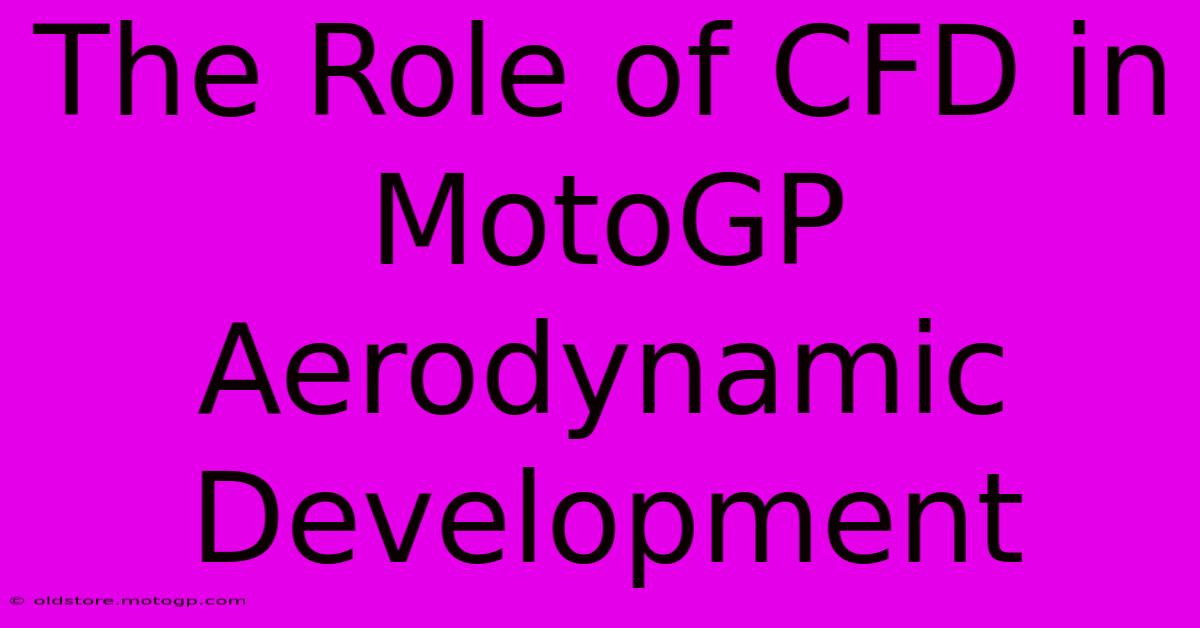The Role Of CFD In MotoGP Aerodynamic Development

Table of Contents
The Role of CFD in MotoGP Aerodynamic Development
The roar of the engines, the blur of speed, the breathtaking overtakes – MotoGP is a spectacle of precision engineering and raw power. Behind the thrilling races lies a world of meticulous design and development, with Computational Fluid Dynamics (CFD) playing a pivotal role in optimizing aerodynamic performance. This article delves into the crucial role of CFD in shaping the cutting-edge aerodynamics of MotoGP motorcycles.
Understanding CFD's Impact on MotoGP Aerodynamics
Computational Fluid Dynamics is a powerful tool that uses complex algorithms to simulate the flow of air around an object. In the context of MotoGP, CFD allows engineers to virtually test different aerodynamic designs on a motorcycle, analyzing how air interacts with various components like fairings, wings, and spoilers. This virtual testing significantly reduces the need for expensive and time-consuming wind tunnel testing, although wind tunnel validation remains crucial.
Key Applications of CFD in MotoGP:
-
Fairing Design Optimization: CFD helps optimize the shape of the fairing, minimizing drag and maximizing downforce. By analyzing airflow patterns, engineers can fine-tune the fairing's contours to reduce air resistance while maintaining stability at high speeds. This is critical for achieving higher top speeds and improved fuel efficiency.
-
Wing Design and Development: The winglets and aerodynamic appendages found on modern MotoGP bikes are a testament to the advancements made through CFD. These components generate downforce, crucial for high-speed cornering and stability, without significantly increasing drag. CFD simulations help determine the optimal size, shape, and placement of these wings to maximize their performance.
-
Rider Positioning and Ergonomics: The rider's position significantly impacts aerodynamics. CFD helps engineers understand how the rider interacts with the airflow, minimizing turbulence and drag. This leads to designs that improve both rider comfort and aerodynamic efficiency.
Advantages of Using CFD in MotoGP Development:
-
Cost-Effectiveness: Compared to building and testing numerous physical prototypes in a wind tunnel, CFD offers a significantly more affordable approach to aerodynamic development.
-
Speed and Efficiency: CFD simulations can be run and analyzed much faster than physical wind tunnel testing, allowing engineers to explore a wider range of design options in a shorter time frame.
-
Detailed Analysis: CFD provides detailed insights into airflow patterns, pressure distributions, and other aerodynamic parameters that are difficult to measure accurately in a wind tunnel. This granular data enables engineers to make precise adjustments for optimal performance.
-
Early-Stage Design Exploration: CFD can be used early in the design process to evaluate different concepts, helping teams identify promising designs before committing to physical prototypes.
The Future of CFD in MotoGP Aerodynamics
The use of CFD in MotoGP is continuously evolving. Advancements in computing power and simulation techniques are enabling more accurate and sophisticated simulations, leading to even more refined aerodynamic designs. The integration of machine learning and artificial intelligence is likely to further enhance the efficiency and effectiveness of CFD in the future, enabling the development of even faster and more agile MotoGP machines. We can expect to see even more innovative aerodynamic solutions emerging as technology progresses.
Conclusion
CFD has become an indispensable tool in the relentless pursuit of aerodynamic perfection in MotoGP. Its ability to simulate airflow with remarkable accuracy, coupled with its cost-effectiveness and efficiency, has revolutionized the way teams design and develop their motorcycles. As technology continues to advance, CFD's role in shaping the future of MotoGP aerodynamics will only grow stronger, pushing the boundaries of speed and performance.

Thank you for visiting our website wich cover about The Role Of CFD In MotoGP Aerodynamic Development. We hope the information provided has been useful to you. Feel free to contact us if you have any questions or need further assistance. See you next time and dont miss to bookmark.
Featured Posts
-
Moto Gp Points The Science Behind The Standings
Feb 23, 2025
-
F1 Us Grand Prix Tv Coverage Unmissable Moments Guaranteed
Feb 23, 2025
-
Sprint Race Results Who Took Home The Gold
Feb 23, 2025
-
The Best Motorcyclist A Symbol Of Perseverance
Feb 23, 2025
-
The Allure Of The Open Road Experienced By Famous Motorcycle Riders
Feb 23, 2025
